| 2016-2017 TEI4M Engineering Tasks |
![]() ER Flex Circuit. For your final ER entry you will continue the tradition of adding a live circuit page to your ACES' archive. First introduced last year, the 2015-2016 ACES produced a solar-powered laminated page of their own design, based on an SOIC-8 ATtiny85. Check out their results. Your final circuit will be submitted to Mr. D., in class, Period 1, on Tuesday May 2 (No APs that morning). This leaves the rest of May to focus on your Long ISP, as your last responsibility to the ACES program, except to show up for Graduation and receive your hard hat and bound ER. Here is your list of proposed Flex Circuits.
ER Flex Circuit. For your final ER entry you will continue the tradition of adding a live circuit page to your ACES' archive. First introduced last year, the 2015-2016 ACES produced a solar-powered laminated page of their own design, based on an SOIC-8 ATtiny85. Check out their results. Your final circuit will be submitted to Mr. D., in class, Period 1, on Tuesday May 2 (No APs that morning). This leaves the rest of May to focus on your Long ISP, as your last responsibility to the ACES program, except to show up for Graduation and receive your hard hat and bound ER. Here is your list of proposed Flex Circuits.
| ATtiny85 SOIC-8 | PowerFilm Solar Cell / Surfboard 9081 |
|---|---|
 |
 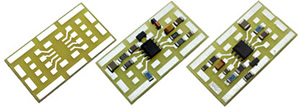 |
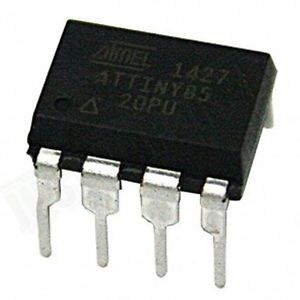
![]() ER Flex Page Part 1. THT Prototype. Your final flex circuit will see an SMT ATtiny85 soldered to a 9081 Surfboard® as depicted above and below, right. To this end you are to design and implement an interesting through-hole prototype using parts from your inventory. Your kit contains resistors, LEDs and an ATtiny85 in an DIP-8 package.
ER Flex Page Part 1. THT Prototype. Your final flex circuit will see an SMT ATtiny85 soldered to a 9081 Surfboard® as depicted above and below, right. To this end you are to design and implement an interesting through-hole prototype using parts from your inventory. Your kit contains resistors, LEDs and an ATtiny85 in an DIP-8 package.
You can flash your '85 with your Sparkfun Pocket Programmer.
The circuit must run on no more than 3.6V and draw no more than 100 mA.
Submit your ER to handin no later than Saturday April 15 under the Subject Line: ER Flex Page: THT Prototype
For Part 2 of this project, you will be supplied with the SOIC-8 SMT version of the ATtiny85. Together with LEDs, resistors and buttons in the 1206 package, similar to the ones you used in your previous SMT1 DC Power Jack project, you will complete your Flex Page.
![]() ER Flex Page Part 2. SMT Final. OK, this is going to take some skill and creativity. Please do not procrastinate and jeopardize an otherwise impressive ER archive.
ER Flex Page Part 2. SMT Final. OK, this is going to take some skill and creativity. Please do not procrastinate and jeopardize an otherwise impressive ER archive.
| 1796-ADA SMT Test Socket - Medium SOIC-8 (ATtiny85) | Surfboard 9081 |
|---|---|
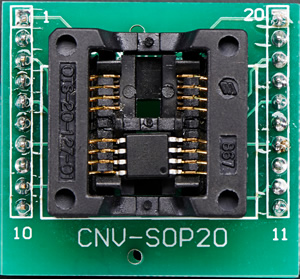 |
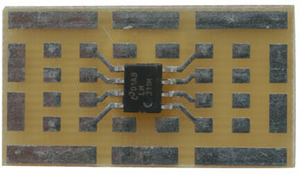 |
| 1283-ADA SMT Test Socket - Narrow Breakout SOIC-16 (ATtiny84) | Surfboard 9161 |
 |
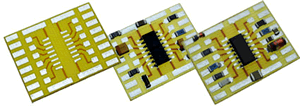 |
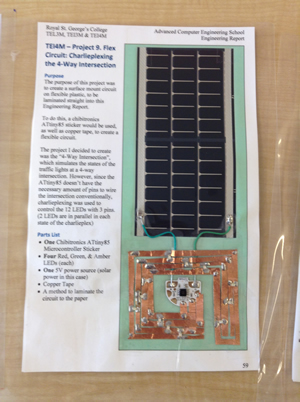 You're going after something unique; a solar-powered live curcuit embedded in a page within your Engineering Report. in the furuee, when you show your ER the light od day you'll marvel at what you accomplished in high school. A photo of Ryan Power's effort last year looks much like th formatting of all the other pages in his ER except the cutaway is an intersection circuit that goes live when placed in sunlight due the to MPT3.6-150 solar panel laminated into the page. His ER Report continues on the backside of the page.
You're going after something unique; a solar-powered live curcuit embedded in a page within your Engineering Report. in the furuee, when you show your ER the light od day you'll marvel at what you accomplished in high school. A photo of Ryan Power's effort last year looks much like th formatting of all the other pages in his ER except the cutaway is an intersection circuit that goes live when placed in sunlight due the to MPT3.6-150 solar panel laminated into the page. His ER Report continues on the backside of the page.
Task.
![]() DC Power Jack. Your experience with electric circuits has been largely limited to components that use through-hole technology (THT). To round out your proficiency with all components, your next few projects will require the use of devices that use surface-mount technology (SMT). As the graphic reveals, the smallest size that is reasonable for hand-soldering techniques is the 1206 family, so this is what we carry in the DES inventory.
DC Power Jack. Your experience with electric circuits has been largely limited to components that use through-hole technology (THT). To round out your proficiency with all components, your next few projects will require the use of devices that use surface-mount technology (SMT). As the graphic reveals, the smallest size that is reasonable for hand-soldering techniques is the 1206 family, so this is what we carry in the DES inventory.
DC Jack PCB |
1206 LED Package |
|---|---|
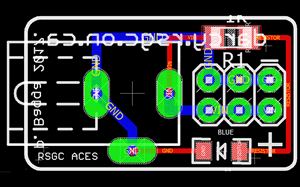 |
Task.
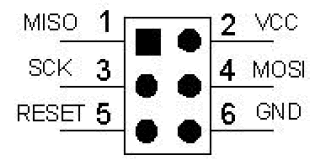
![]() Blink. Your experience with AVR microcontrollers has been largely limited to the Arduino and its onboard ATmega328P. For many of your projects to this point the mega has been overkill in that it offers far more I/O pins than you've needed. This task introduces you to a smaller AVR microcontroller, the ATtiny85, and gives you a chance to confirm that your AVR assembly skills are equally applicable to other family members. For many of you, this is also the first time you've left the comfort of the Arduino and programmed a microcontroller on a breadboard. The real benefit of this task is the familiarity you gain with a more compact microprocessor logic foundation for future ISPs.
Blink. Your experience with AVR microcontrollers has been largely limited to the Arduino and its onboard ATmega328P. For many of your projects to this point the mega has been overkill in that it offers far more I/O pins than you've needed. This task introduces you to a smaller AVR microcontroller, the ATtiny85, and gives you a chance to confirm that your AVR assembly skills are equally applicable to other family members. For many of you, this is also the first time you've left the comfort of the Arduino and programmed a microcontroller on a breadboard. The real benefit of this task is the familiarity you gain with a more compact microprocessor logic foundation for future ISPs.
Task.
 Two of the new components you'll require for this task can be found in your toolkit (ATtiny85, Sparkfun's AVR Pocket Programmer)
Two of the new components you'll require for this task can be found in your toolkit (ATtiny85, Sparkfun's AVR Pocket Programmer)